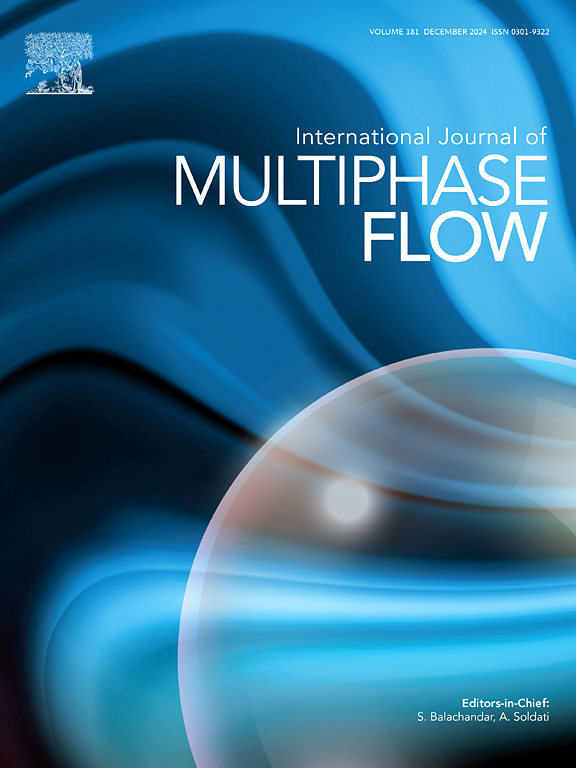表面活性剂对粘弹性同轴电喷雾影响的实验研究
IF 3.6
2区 工程技术
Q1 MECHANICS
International Journal of Multiphase Flow
Pub Date : 2025-04-08
DOI:10.1016/j.ijmultiphaseflow.2025.105251
引用次数: 0
摘要
本研究研究了通过同轴电喷雾将葵花籽油封装在粘弹性海藻酸盐溶液中的核壳锥射流的形成,特别强调了表面活性剂添加对表面张力的影响。海藻酸盐是一种天然存在的线性多糖,由于其成本低、易于使用和生物相容性好而被广泛用作包封剂。通过调节同轴喷嘴与接地电极之间的外加电势,采用高速成像技术捕获各种电流体动力模式。系统分析了操作参数和表面活性剂添加量对锥形射流轮廓形成的影响。结果表明,表面活性剂的加入使稳定锥喷流区域扩大了132.8%(2.33倍),即使在较低的韦伯数下也能形成稳定锥喷流。表面活性剂增强了岩心和壳层流体之间的混相,形成波纹状界面,导致半月板射流直径增大。然而,射流在较低韦伯数下的稳定性促进了更小粒子的产生。随着Weber数的增加,锥角呈现先减小后增大的趋势,这与藻酸盐溶液在不同剪切速率下粘弹性行为的变化有关。此外,由于表面张力的降低,表面活性剂的使用降低了外部和内部流体的锥角。本文章由计算机程序翻译,如有差异,请以英文原文为准。

Experimental investigation of surfactant influence on the viscoelastic coaxial electrospray
This study investigates the formation of a core-shell cone jet for encapsulating sunflower oil within a viscoelastic alginate solution via coaxial electrospray, with particular emphasis on the impact of surface tension by surfactant addition. Alginate, a naturally occurring linear polysaccharide, is widely used as an encapsulant due to its low cost, ease of use, and biocompatibility. High-speed imaging was employed to capture various electrohydrodynamic (EHD) modes by adjusting the applied electric potential between the coaxial nozzle and the ground electrode. The influence of operating parameters and surfactant addition on the formation of cone jet profiles was systematically analyzed. The results demonstrate that surfactant addition expanded the stable cone jet region by 132.8 % (2.33 times) on the operating maps, enabling the formation of a stable cone jet even at low Weber numbers. Surfactants enhance the miscibility between the core and shell fluids, and induce a corrugated interface, leading to an increase in the meniscus jet diameter. However, the stability of the jet at lower Weber numbers facilitated the creation of smaller particles. As the Weber number increased, the cone angle initially decreased and then increased, which is attributed to the changing viscoelastic behavior of the alginate solution under varying shear rates. Additionally, the use of surfactants reduced the cone angle of both the outer and inner fluids due to a decrease in surface tension forces.
求助全文
通过发布文献求助,成功后即可免费获取论文全文。
去求助
来源期刊
CiteScore
7.30
自引率
10.50%
发文量
244
审稿时长
4 months
期刊介绍:
The International Journal of Multiphase Flow publishes analytical, numerical and experimental articles of lasting interest. The scope of the journal includes all aspects of mass, momentum and energy exchange phenomena among different phases such as occur in disperse flows, gas–liquid and liquid–liquid flows, flows in porous media, boiling, granular flows and others.
The journal publishes full papers, brief communications and conference announcements.

 求助内容:
求助内容: 应助结果提醒方式:
应助结果提醒方式:


